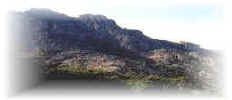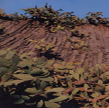 environment
environment
. Some are to be seen or may be found in the tips in this area. Choosing
different areas, it is still possible to find several minerals such as for
example anglesite, cerussite, ga!ena, blende, blende var., marmatite,
sidente, quartz, pyrite, malachite, azzurrite and barite. The anglesites
of Montevecchio are famous for their green colouring, often of an emerald
hue, due to the iron sulphate present in them. Very often on a limonitic
matrix, rarely with quartz or galena, the green anglesites are to be found
in crystals which only occasionally exceed 3 cms in length. Cerussite on
the other hand was found mainly in elongated crystals, often in the form
of needles, of colour varying from white to yellow or dark brown because
of the limonite which often covered it. Some series of sampies from the
areas of Telle and Sanna have a fine colouring and considerabie
fluorescence to ultraviolets which would iead one to think that there has
been a substitution of cerussite by phosgenite.The barite which is found
in the deep leveis of the Sartori shaft is the most beautiful and elegant
which the mines of Sardinia have produced. It is also stili possible to
find sampies of marmatite on the candid quartz of rhe Casargius working.It
is not always advisable to wander round the open cast workings which are
very dangerous as a result of the instability of the biocks of stone and
the stone walls themseives. It is advisable to go on these visits
accompanied by persons who know the area well. Access to this area is by
means of several roads, all in excellent condition.On
the slopes of the "Cuccureddu and Zeppara" hill at the Eastern
periphery of the town, there is a basalt quarry. In front of the quarry,
which
Some are to be seen or may be found in the tips in this area. Choosing
different areas, it is still possible to find several minerals such as for
example anglesite, cerussite, ga!ena, blende, blende var., marmatite,
sidente, quartz, pyrite, malachite, azzurrite and barite. The anglesites
of Montevecchio are famous for their green colouring, often of an emerald
hue, due to the iron sulphate present in them. Very often on a limonitic
matrix, rarely with quartz or galena, the green anglesites are to be found
in crystals which only occasionally exceed 3 cms in length. Cerussite on
the other hand was found mainly in elongated crystals, often in the form
of needles, of colour varying from white to yellow or dark brown because
of the limonite which often covered it. Some series of sampies from the
areas of Telle and Sanna have a fine colouring and considerabie
fluorescence to ultraviolets which would iead one to think that there has
been a substitution of cerussite by phosgenite.The barite which is found
in the deep leveis of the Sartori shaft is the most beautiful and elegant
which the mines of Sardinia have produced. It is also stili possible to
find sampies of marmatite on the candid quartz of rhe Casargius working.It
is not always advisable to wander round the open cast workings which are
very dangerous as a result of the instability of the biocks of stone and
the stone walls themseives. It is advisable to go on these visits
accompanied by persons who know the area well. Access to this area is by
means of several roads, all in excellent condition.On
the slopes of the "Cuccureddu and Zeppara" hill at the Eastern
periphery of the town, there is a basalt quarry. In front of the quarry,
which  is no longer active, there are some excellent examples of columnar basalt.
This formation was caused during the cooling of the melted mass by means
of its contraction and splitting. It can be reached easily by car.The town
is situated in a hollow, at the edge of the Campidano plain on the slopes
of the Arburese hill system in the vicinity of the Rio Terra Maistus and
its tributaries the Riu Crabas and Riu s’Acqua bella. The oldest part of
the town, whìch has the form of an irreguiar circie, grew up initialiy
along the East - West road axis and then occupied the territory in
directions at right angles to this axis with a preference for the
directjon along Higlway 196 which links it with the nearby towns of
Villacidro and Gonnosfanadiga.
is no longer active, there are some excellent examples of columnar basalt.
This formation was caused during the cooling of the melted mass by means
of its contraction and splitting. It can be reached easily by car.The town
is situated in a hollow, at the edge of the Campidano plain on the slopes
of the Arburese hill system in the vicinity of the Rio Terra Maistus and
its tributaries the Riu Crabas and Riu s’Acqua bella. The oldest part of
the town, whìch has the form of an irreguiar circie, grew up initialiy
along the East - West road axis and then occupied the territory in
directions at right angles to this axis with a preference for the
directjon along Higlway 196 which links it with the nearby towns of
Villacidro and Gonnosfanadiga.